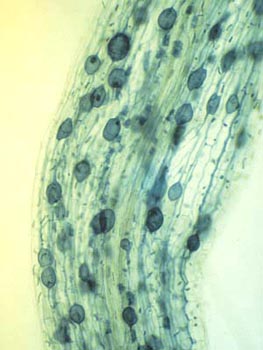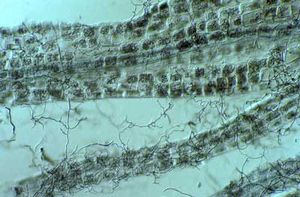Endomycorrhizal fungi: Difference between revisions
No edit summary |
|||
| Line 1: | Line 1: | ||
==Introduction== | ==Introduction== | ||
Endomycorrhizal fungi (more commonly referred to as endomycorrhizae) is one of the major types of known mycorrhizae which differs from the another type of mycorrhizae, ectomycorrhizae, in structure. Unlike ectomycorrhizae which form a system of hyphae that grow around the cells of the root, the hyphae of the endomycorrhizae not only grow inside the root of the plant but penetrate the root cell walls and become enclosed in the cell membrane as well. This makes for a more invasive symbiotic relationship between the fungi and the plant. The penetrating hyphae create a greater contact surface area between the hyphae of the fungi and the plant. This heightened contact facilitates a greater transfer of nutrients between the two. Endomycorrhizae have further been classified into five major groups: arbuscular, ericoid, arbutoid, monotropoid, and orchid | Endomycorrhizal fungi (more commonly referred to as endomycorrhizae) is one of the major types of known mycorrhizae which differs from the another type of mycorrhizae, ectomycorrhizae, in structure. Unlike ectomycorrhizae which form a system of hyphae that grow around the cells of the root, the hyphae of the endomycorrhizae not only grow inside the root of the plant but penetrate the root cell walls and become enclosed in the cell membrane as well (1). This makes for a more invasive symbiotic relationship between the fungi and the plant. The penetrating hyphae create a greater contact surface area between the hyphae of the fungi and the plant. This heightened contact facilitates a greater transfer of nutrients between the two. Endomycorrhizae have further been classified into five major groups: arbuscular, ericoid, arbutoid, monotropoid, and orchid mycorrhizae (2).<br><br> | ||
[[Image:Endomycorrhiza.jpg|thumb|300px|right|This image depicts the symbiotic relationship between an endomycorrhizal fungus in alfalfa root http://jpkc.sdau.edu.cn/zbgpp/vocabulary/endomycorrhiza.htm]] | [[Image:Endomycorrhiza.jpg|thumb|300px|right|This image depicts the symbiotic relationship between an endomycorrhizal fungus in alfalfa root http://jpkc.sdau.edu.cn/zbgpp/vocabulary/endomycorrhiza.htm]] | ||
| Line 6: | Line 6: | ||
<br> <br> | <br> <br> | ||
==Arbuscular Mycorrhizae== | ==Arbuscular Mycorrhizae== | ||
Endomycorrhizae have several functions, the major one being nutrient acquisition. Endomycorrhizae facilitate the exchange of nutrients between the host plant and the soil. Mycorrhizae aid in the uptake of water, inorganic phosphorus, mineral or organic nitrogen, and amino acids. In exchange for the mycorrhizae providing all of these nutrients, the plant in turn provides the mycorrhizae with carbon. This relationship benefits both organisms immensely. The mycorrhizae greatly increase the surface area of the plant’s root system which is hugely beneficial in areas where drought is common. This is also beneficial in areas where the soil is nutrient-poor. The larger surface area gives those plants an advantage over plants lacking this symbiotic relationship allowing plants with mycorrhizal relationships to out-compete for nutrients. Mycorrhizae also offer the roots of the plant a little more protection. <br><br> | Endomycorrhizae have several functions, the major one being nutrient acquisition. Endomycorrhizae facilitate the exchange of nutrients between the host plant and the soil. Mycorrhizae aid in the uptake of water, inorganic phosphorus, mineral or organic nitrogen, and amino acids. In exchange for the mycorrhizae providing all of these nutrients, the plant in turn provides the mycorrhizae with carbon (1). This relationship benefits both organisms immensely. The mycorrhizae greatly increase the surface area of the plant’s root system which is hugely beneficial in areas where drought is common. This is also beneficial in areas where the soil is nutrient-poor. The larger surface area gives those plants an advantage over plants lacking this symbiotic relationship allowing plants with mycorrhizal relationships to out-compete for nutrients. Mycorrhizae also offer the roots of the plant a little more protection (3). <br><br> | ||
==Ericoid Mycorrhizae== | |||
Ericoid mycorrhizae are found in inhospitable environments, particularly acidic environments (5). The fungi involved in this symbiotic relationship are Ascomycota (6). Despite the harsh conditions the mycorrhizae are still able to take up nitrogen and phosphorous for the host plant. The mycorrhizae also helps to regulate the acquisition of iron, manganese and aluminium ions which are often present in highly available forms in acidic soils (6). Ericoid mycorrhizae differ not only in where they are found but also in structure. Instead of forming arbuscules the fungi forms hyphal coils in the exterior cells of the fine root hairs of plants in the family Ericaceae (4). Root volume can be up to eighty percent fungal tissue and it is through these coils that nutrient exchange occurs. These fungi can actually be found free-living in the soil but the symbiotic relationship between the fungi and plant is thought to be more beneficial to both species (6). | |||
[[Image:I-eric1.jpg|thumb|300px|right|This image depicts the hyphal coils of an ericoid mycorrhizae http://mycorrhizas.info/ozplants/l-eric1.jpg]] | |||
<br> <br> | |||
==Function of Endomycorrhizal fungi== | |||
Endomycorrhizae have several functions, the major one being nutrient acquisition. Endomycorrhizae facilitate the exchange of nutrients between the host plant and the soil. Mycorrhizae aid in the uptake of water, inorganic phosphorus, mineral or organic nitrogen, and amino acids. In exchange for the mycorrhizae providing all of these nutrients, the plant in turn provides the mycorrhizae with carbon. This relationship benefits both organisms immensely. The mycorrhizae greatly increase the surface area of the plant’s root system which is hugely beneficial in areas where drought is common. This is also beneficial in areas where the soil is nutrient-poor. The larger surface area gives those plants an advantage over plants lacking this symbiotic relationship allowing plants with mycorrhizal relationships to out-compete for nutrients. Mycorrhizae also offer the roots of the plant a little more protection (1). <br><br> | |||
==Conclusion== | ==Conclusion== | ||
| Line 16: | Line 26: | ||
==References== | ==References== | ||
(1) [http://www.nature.com/ncomms/journal/v1/n4/full/ncomms1046.html Bonfante, P., and Genre, A. "Mechanisms underlying beneficial plant-fungus interactions in mycorrhizal symbiosis." Nature Communications 48 (2010).] | |||
(2) [Peterson, R. L.; Massicotte, H. B. & Melville, L. H. (2004). Mycorrhizas: anatomy and cell biology. National Research Council Research Press. ISBN 978-0-660-19087-7.] | |||
(3) [http://mycorrhizas.info/vam.html Brundrett, M. "MYCORRHIZAL ASSOCIATIONS: The Web Resource." Mycorrhizal Associations: Arbuscular Mycorrhizas. N.p., 2008.] | |||
(4) [http://aggie-horticulture.tamu.edu/faculty/davies/research/mycorrhizae.html Davies, F. "Dr. Davies Research Page." Dr. Davies Research Page. Texas A&M University, n.d.] | |||
(5) [Smith SE & Read DJ (2008) Mycorrhizal Symbiosis. Academic press, London.] | |||
(6) [http://www.davidmoore.org.uk/assets/mostly_mycology/diane_howarth/ericoid.htm Moore, D. "David Moore's World of Fungi: Where Mycology Starts." Ericoid Mycorrhizas. David Moore, n.d. (2013)] | |||
<br>Edited by | <br>Edited by Alexandra Schaal, student of [mailto:slonczewski@kenyon.edu Joan Slonczewski] for [http://biology.kenyon.edu/courses/biol116/biol116_Fall_2013.html BIOL 116 Information in Living Systems], 2013, [http://www.kenyon.edu/index.xml Kenyon College]. | ||
<!--Do not edit or remove this line-->[[Category:Pages edited by students of Joan Slonczewski at Kenyon College]] | <!--Do not edit or remove this line-->[[Category:Pages edited by students of Joan Slonczewski at Kenyon College]] | ||
Revision as of 03:04, 6 December 2013
Introduction
Endomycorrhizal fungi (more commonly referred to as endomycorrhizae) is one of the major types of known mycorrhizae which differs from the another type of mycorrhizae, ectomycorrhizae, in structure. Unlike ectomycorrhizae which form a system of hyphae that grow around the cells of the root, the hyphae of the endomycorrhizae not only grow inside the root of the plant but penetrate the root cell walls and become enclosed in the cell membrane as well (1). This makes for a more invasive symbiotic relationship between the fungi and the plant. The penetrating hyphae create a greater contact surface area between the hyphae of the fungi and the plant. This heightened contact facilitates a greater transfer of nutrients between the two. Endomycorrhizae have further been classified into five major groups: arbuscular, ericoid, arbutoid, monotropoid, and orchid mycorrhizae (2).

Arbuscular Mycorrhizae
Endomycorrhizae have several functions, the major one being nutrient acquisition. Endomycorrhizae facilitate the exchange of nutrients between the host plant and the soil. Mycorrhizae aid in the uptake of water, inorganic phosphorus, mineral or organic nitrogen, and amino acids. In exchange for the mycorrhizae providing all of these nutrients, the plant in turn provides the mycorrhizae with carbon (1). This relationship benefits both organisms immensely. The mycorrhizae greatly increase the surface area of the plant’s root system which is hugely beneficial in areas where drought is common. This is also beneficial in areas where the soil is nutrient-poor. The larger surface area gives those plants an advantage over plants lacking this symbiotic relationship allowing plants with mycorrhizal relationships to out-compete for nutrients. Mycorrhizae also offer the roots of the plant a little more protection (3).
Ericoid Mycorrhizae
Ericoid mycorrhizae are found in inhospitable environments, particularly acidic environments (5). The fungi involved in this symbiotic relationship are Ascomycota (6). Despite the harsh conditions the mycorrhizae are still able to take up nitrogen and phosphorous for the host plant. The mycorrhizae also helps to regulate the acquisition of iron, manganese and aluminium ions which are often present in highly available forms in acidic soils (6). Ericoid mycorrhizae differ not only in where they are found but also in structure. Instead of forming arbuscules the fungi forms hyphal coils in the exterior cells of the fine root hairs of plants in the family Ericaceae (4). Root volume can be up to eighty percent fungal tissue and it is through these coils that nutrient exchange occurs. These fungi can actually be found free-living in the soil but the symbiotic relationship between the fungi and plant is thought to be more beneficial to both species (6).

Function of Endomycorrhizal fungi
Endomycorrhizae have several functions, the major one being nutrient acquisition. Endomycorrhizae facilitate the exchange of nutrients between the host plant and the soil. Mycorrhizae aid in the uptake of water, inorganic phosphorus, mineral or organic nitrogen, and amino acids. In exchange for the mycorrhizae providing all of these nutrients, the plant in turn provides the mycorrhizae with carbon. This relationship benefits both organisms immensely. The mycorrhizae greatly increase the surface area of the plant’s root system which is hugely beneficial in areas where drought is common. This is also beneficial in areas where the soil is nutrient-poor. The larger surface area gives those plants an advantage over plants lacking this symbiotic relationship allowing plants with mycorrhizal relationships to out-compete for nutrients. Mycorrhizae also offer the roots of the plant a little more protection (1).
Conclusion
Overall text length should be at least 1,000 words (before counting references), with at least 2 images. Include at least 5 references under Reference section.
References
(2) [Peterson, R. L.; Massicotte, H. B. & Melville, L. H. (2004). Mycorrhizas: anatomy and cell biology. National Research Council Research Press. ISBN 978-0-660-19087-7.]
(4) Davies, F. "Dr. Davies Research Page." Dr. Davies Research Page. Texas A&M University, n.d.
(5) [Smith SE & Read DJ (2008) Mycorrhizal Symbiosis. Academic press, London.]
Edited by Alexandra Schaal, student of Joan Slonczewski for BIOL 116 Information in Living Systems, 2013, Kenyon College.
